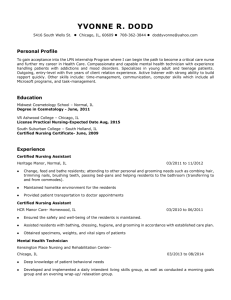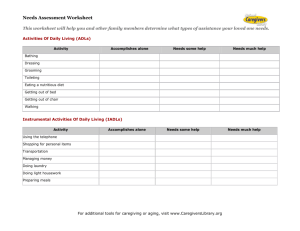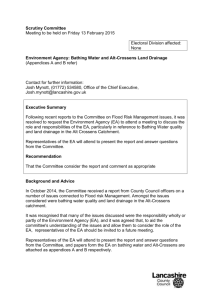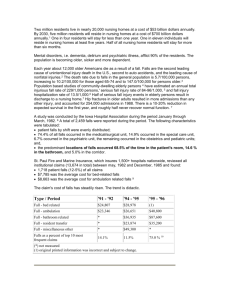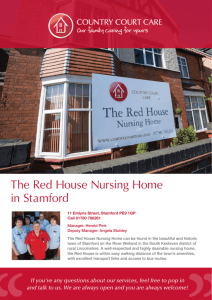Check out our powerpoint! - Summer Rain Shower Chair
advertisement
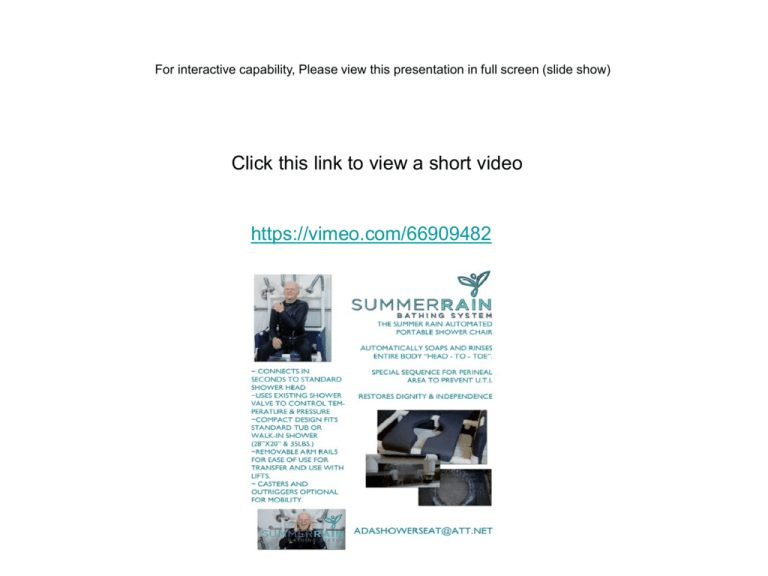
For interactive capability, Please view this presentation in full screen (slide show) Click this link to view a short video https://vimeo.com/66909482 Patient Needs People requiring bathing assistance expect to be cleaned in a safe and non-harmful manner. The reality is that patients continue to be scalded in tubs or experience unnecessary urinary tract infections (UTI). The cause of a UTI is the bacteria and fungal entrapment inherent in tubs or the inability of the attendant to sufficiently cleanse the perineal area using a traditional shower chair. These infections cause fever, dizziness, loss of mental acuity, decline in independence and falls. Hospitalization is often required for broken bones, dislocations and traumatic head injury. Problems with Traditional Shower Chair Bathing It is practically impossible to clean the buttocks and groin areas of the (perineum) in an effective manner. The manual swipe of the wash cloth spreads the bacteria and is a major cause of urinary tract infections (UTI) Patients become uncomfortable on the typical hard, unstable shower seat or bench which results in injury to both patient and assistant. The patient and nurses relationship is strained from the anxiety caused by the traditional invasive bathing process. The Inherent Problem with Tubs Besides the obvious problems of scalding and accessibility the foremost problem of the tub bath is the design. Bathwater does not completely drain from the pump and pipes. Instead, it remains in the damp, dark environment--the perfect breeding ground for bacteria--until the next time someone uses the bath. This water often includes soap film, hair, dead skin, body oil, dirt, and feces. The pathogens then come rushing out of the pipes, into the air and the "clean" bathwater. The person taking the bath is subject to inhaling and ingesting bacteria, along with immersing themselves in a variety of pathogens. This has resulted in widespread litigation. Additionally, tubs are expensive to operate and require more time and water to bathe patients than any other method. Therefore the tub has been practically dismissed by long term care facilities and the healthcare industry. Relaxing in Filth: What Your Whirlpool Tub May Be Hiding1 1Waterborne Pathogens - A List of Infectious Agents That Could Be Swimming With You Source: www.awwarf.com/newprojects/factshts.html “We need to assure our residents that we are not introducing infectious agents to them through tub baths or unsanitary, manual, invasive bathing practices” Base Rate; $223 a Day Problems for NF’s The percentage of the top ten deficiencies given in 2007 to nursing facilities for problems which can result in a negative impact on the health and safety of residents were: Accidental environment 37%, food sanitation 35%, quality of care 29%, professional standards 28%, comprehensive care plan 22%, housekeeping 20%, Incontinence/urinary care 19%, pressure sores 19%, unnecessary drugs 19%, and infection control 18%. (Note: Data are for community hospitals, which represent 85% of all hospitals) Staff Injury Nursing Home Inspections: (2002) The Occupational Safety and Health Administration said that it will begin this year inspecting 1,000 nursing or personal care facilities out of 2,500 that reported high injury and illness rates under a new National Emphasis Program. The program focuses on specific hazards that account for the majority of nursing home staff injuries and illnesses, including ergonomic back injuries from patient handling and slips, trips and falls. Litigation According to the nursing home industry, plaintiffs' lawyers are targeting a vulnerable industry, unfairly charging the homes with causing the deteriorating condition or death of residents who were already in severely declining health. Plaintiffs' lawyers charge that nursing homes are providing substandard care and are operating at inadequate staffing levels. Key Benefits of Automated Shower Chair • • • • Reduction of UTI and infection Reduction of accidental environment incidents Improved quality of care and professional standards Increased patient through put (reduced time for bathing) • Improved nurses job satisfaction and reduction of staff injury and risk • Improved relationship between nurse and patient • Comfort and dignity are restored for all Body wash is automatically dispensed and thoroughly rinsed. Enables showering while in a comfortable, stable seated position Seat exposes the perineum to automated dispense nozzles Eliminates the need for the manual invasive perineal swipe Attendant can supervise and control the process without touching Improved care of pressure sores and skin lesions Improves accessibility and reduces effort to bathe Increases residents desire to bathe Mobile and easily adaptable to most bathing environments Improves Hygiene throughout the facility Reduces water usage and clean up time Improves staff efficiency, a true force multiplier Restores comfort and dignity for staff and residents Mitigate Liability The facility can prevent the charge of causing the deteriorating condition or death of residents who were already in declining health. Reduces the claim that nursing homes are systematically operating at inadequate staffing levels. Immediate Need in Licensed NF’s • 17,000 facilities • 107 average bed count (currently 89% aor) • 30 minute average bathing (shower) cycle = 16 showers in an eight hour day per unit X 7 days a week = 112 showers a week per • Each resident should be offered 3 baths or showers per week; 3 X 107 = 321 • 321 / 112 = 2.86 avg. required per facility • 2.86 X 17,000 = 48,620 Shower Units Assisted Living Communities Approximately 75% of the almost 1 million residents in assisted living facilities are female. The average age of residents is between 80 and 83 years old. (These are the most vulnerable to UTI) Most people—nearly 79%—who need Long-Term Care live at home or in community settings, not in institutions. Informal Care More than 65 million people, 29% of the U.S. population, provide care for a chronically ill, disabled or aged family member or friend during any given year and spend an average of 20 hours per week providing care for their loved one. Caregiving in the United States; National Alliance for Caregiving in collaboration with AARP; November 2009 The value of the services family caregivers provide for "free," when caring for older adults, is estimated to be $375 billion a year. That is almost twice as much as is actually spent on homecare and nursing home services combined ($158 billion). Evercare Survey of the Economic Downturn and Its Impact on Family Caregiving; The typical family caregiver is a 49-year-old woman caring for her widowed 69-year-old mother who does not live with her. She is married and employed. Approximately 66% of family caregivers are women. More than 37% have children or grandchildren under 18 years old living with them. Caregiving in the United States; National Alliance for Caregiving in collaboration with AARP. November 2009 20 hours per week is the average number of hours family caregivers spend caring for their loved ones while 13% of family caregivers are providing 40 hours of care a week or more. Caregiving in the United States; National Alliance for Caregiving in collaboration with AARP. November 2009 Disability Statistics According to the U. S. Census Bureau, about 49.7 million Americans have a disability, which includes people of all ages. About two-thirds of these individuals have a severe disability. Statistical information about persons with disabilities can be obtained from the U.S. Census Bureau Web site, or by phone at 301-457-3242. Additional sources of disability statistics can be found online at Disability.gov . By the year 2030, more than 70 million Americans will be 65 years old or older, making up 20% of the population, up from 35 million in 2000. The long term care industry will serve and care for many of these seniors. Conclusion Technology is now available that improves the bathing experience for all. The facility can ensure that they are providing the best and safest possible bathing care. “There is no voice stronger than the still small voice of the human conscience” (Gandhi)

